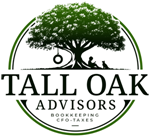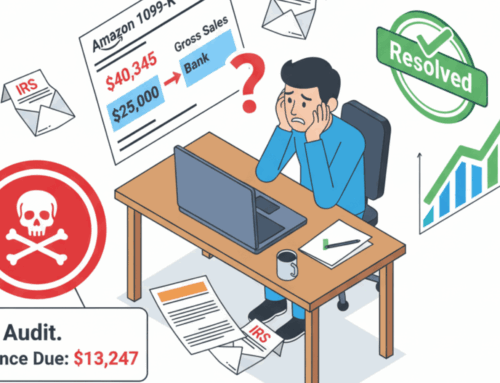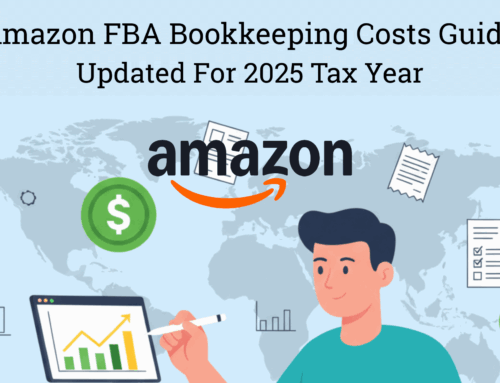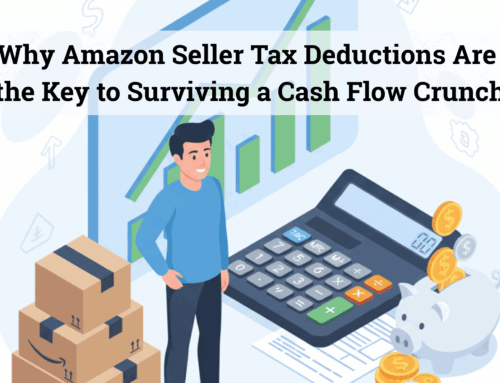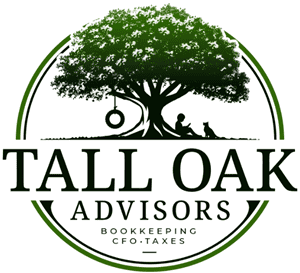Most sellers show up unprepared and get dismissed. This framework flips the script — turning you from another reseller into the brand’s Amazon solution.
key points
An Amazon seller trade show strategy separates professionals from amateurs. While most show up unprepared and beg for price lists, the sellers with a plan stand out, build trust, and win brand partnerships.
If you want to land high-value, long-term brand partnerships, you can’t walk in like a catalog-chaser. You need to walk in like a brand growth partner. That means preparation, professionalism, and the ability to show brands how you’ll help them win on Amazon.
This playbook will show you how to do it.
What’s In This Article?

The Brand’s Pain (What Most Sellers Miss)
Before we talk about you, let’s talk about them. Brands don’t need more resellers. They need solutions to their biggest Amazon headaches:
- Unauthorized sellers gutting MAP and destroying margins.
- Bad listings that undercut conversions and waste traffic.
- Runaway PPC costs with no clear ROI.
- Returns and reimbursements slicing profits.
- Chaos and opacity from Amazon itself
When you show up without a plan, you’re reinforcing the stereotype that Amazon resellers are sloppy, margin-killing opportunists. The only way to break through is to show that you can bring competence and clarity to their problems.
What to Bring to a Trade Show as an Amazon Seller (Pro Prep Checklist)

If you want brands to take you seriously, you need signals of professionalism. Not a full P&L, but tools that prove you’re running a real business.

Clean Financial Snapshot
- A one-pager showing revenue, ad spend efficiency, SKU-level profitability.
- If you don’t have this, you’ll look like a hobbyist. (We help sellers set up bookkeeping systems so you can walk into a trade show looking like a professional, not an amateur.)
- What if you’re only doing $10K/month? That’s okay. The key is not the size of your business but the clarity of your numbers. A brand would rather see a small but organized seller than a big seller with messy books. Even showing, “Here’s how I track costs, here’s my margin by SKU, and here’s how I run ads profitably,” proves you operate like a professional.
- If your numbers are lean, frame them as proof you’ve learned to run efficiently and are ready to scale with the right brand partner.
Portfolio Sheet
- Before/after examples of Amazon listings you’ve improved.
- Screenshots showing ACoS drops, conversion lifts, or review growth.
- Even small wins on your own listings prove you understand the mechanics.
- But what if you don’t have these yet? That’s most resellers. Since Amazon often blocks resellers from editing or creating listings, you won’t be able to showcase before/after examples from your own account. Instead, build a “hypothetical portfolio” by doing brand audits: pick a few listings from brands you’d like to work with, highlight the errors or missed opportunities (bad images, weak bullets, keyword gaps), and then outline what you would do to fix them. This shows your eye for improvement, even if you haven’t executed it yet.
- Think of it as a consulting preview — not proof of past work, but proof of insight. Brands care more about whether you can see the problems than whether you’ve had permission to fix them before.
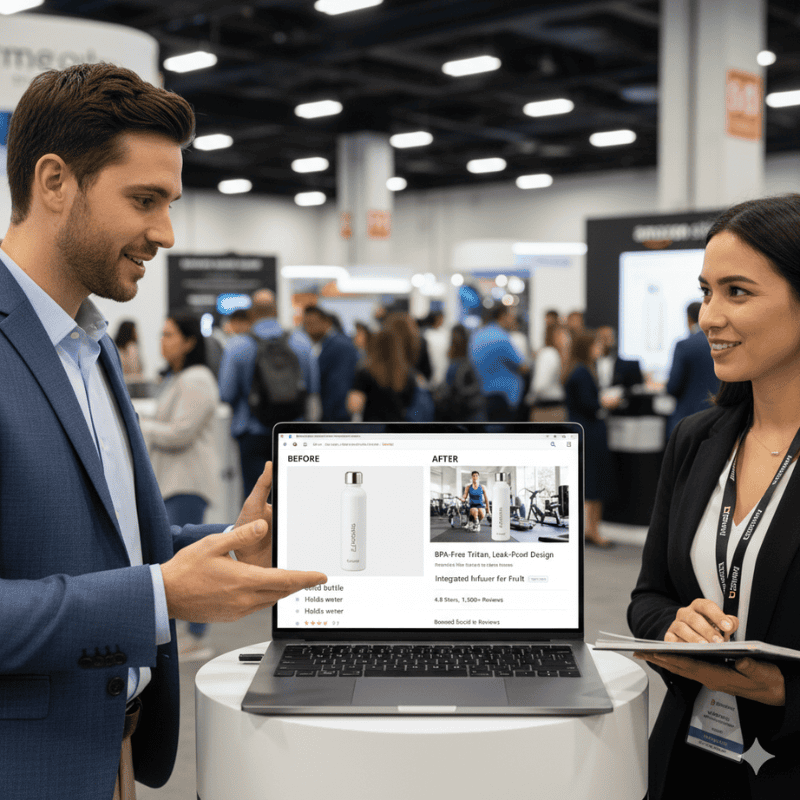

Brand Report Card (Your Secret Weapon)
A one-page audit of their Amazon presence: listing errors, missing keywords, unauthorized sellers, PPC inefficiencies.
Tools like SmartScout make this easy: you can pull competitor data, keyword gaps, reseller counts, and even out-of-stock opportunities.
Trade Show Research with SmartScout: Find Brands, Gaps & Ad Opportunities

The worst thing you can do is show up blind. With SmartScout, you walk in with insights no one else has:
- Find Sleeper Brands → Use Subcategory & Brand filters to spot underrepresented brands with low FBA competition
- Catch Out-of-Stock Gaps → The Out-of-Stock filter shows where demand > supply, so you can pitch filling that gap
- Audit Competitors’ Ads → Traffic Graph & Ad Spy reveal where competitors are driving traffic (and how you’d fix the brand’s strategy)
- Protect Pricing → The Brand Tool shows reseller counts so you can highlight MAP enforcement needs
How to Pitch Brands at Trade Shows: Step-by-Step Conversation Script
When you’re in the booth, the goal is to flip the script from “another reseller” to “Amazon growth partner.”
Step 1: Start Conversationally
Instead of asking about price, say:
“I looked at your listings before the show. I came here to specifically meet you. Can I show you two quick things that might be costing you sales?”
They might be skeptical, but it shows you’ve done your research and came there to help them specifically.
Step 2: Pull Out the Brand Report Card
Visual is everything. A one-pager with SmartScout screenshots and clear notes is 100x more persuasive than words. Give this report to them as a leave behind. And make sure your contact information is all over it.
Step 3: Anchor on Losses (Loss Aversion Bias)
Show what they’re losing by not fixing problems:
- “You’re missing 20K searches a month on ‘organic sunscreen’ because of keyword gaps.”
- “Unauthorized sellers are undercutting your MAP pricing by 15%.”
“You’re likely losing 1–3% annually on unclaimed Amazon reimbursements.”
Step 4: Position Yourself as the Solution
Frame it simply:
“I don’t just buy product. I help brands protect their pricing from unauthorized sellers, recover money Amazon owes them on lost or damaged inventory, and bring them clear financial reporting so they finally know what they’re making on Amazon.”
Can you see how this is a stronger offer than simply trying to get a price list from them and hope they’ll sell to you?
Case Study: How a Reseller Won a Brand Partnership at ASD
At ASD, a mid-sized reseller who had been struggling with thin margins shifted his approach. Instead of walking into booths asking for price sheets, he researched three brands in advance using SmartScout and built simple one-page reports. When he met a natural products brand at the show, he showed them:
- Their listing errors (low-quality main images, missing A+ content, weak bullets).
- How much they were likely losing on returns and unclaimed reimbursements (supported with screenshots and SmartScout data).
- A specific plan for improvement — from keyword targeting ideas to bundling opportunities and projected profit margins if MAP enforcement was tightened.

The brand’s reps admitted they were overwhelmed and didn’t have internal resources for Amazon. They didn’t care that he only wanted to order a modest amount of inventory to start. They cared that he had done more homework than anyone else they had spoken to that day, and that he showed up with competence they lacked in-house. That’s what got him the partnership.
That’s the difference between creating meaningful relationships vs being just another reseller.
No Prep? A Quick-Start Plan Before Your Next Trade Show
Don’t panic if you don’t have these assets yet. Most sellers don’t. But here’s how to close the gap fast:
- No clean financials? → This matters because brands want to know they’re working with a serious partner, not a side hustle that might vanish tomorrow. Even if you’re small, showing a clear snapshot of revenue, costs, and margin proves you understand your numbers. It builds trust. (We’ll help you set up bookkeeping and tax systems so you look credible and operate with confidence.)
- No case studies? → That’s normal for resellers who can’t edit listings. Instead, use brand audits as your proof of insight. Take a target brand’s Amazon listing, point out where they’re losing traction (bad images, poor bullets, keyword gaps, unauthorized sellers), and show them what you would do. You don’t need past wins to demonstrate you can see the problems.
- No research edge? → SmartScout is the fast lane to building professional-looking brand report cards. It gives you the competitive, catalog, and ad data you can package into one-page audits — the kind of prep that separates you from the 90% of resellers who show up empty-handed.

The New Amazon Seller Trade Show Playbook
Here’s the bottom line:
- Don’t ask for price sheets.
- Do your research and prep in advance and pick 20 companies you want to approach.
- Walk in as a partner, not a reseller. Learn who the people are at these companies and make your approach personal to them.
- Use SmartScout + clean financials to prove you’re different than the average Amazon reseller.
This isn’t easy. It takes a lot of work, but it’s the only way to build a business on Amazon that can whether the onslaught of challenges you face as a reseller. One brand can be worth it’s weight in gold and this is a sure way to present yourself as a professional and give yourself the highest chance of success.
Affiliate Disclaimer
Some of the links in this article are affiliate links, which means we may earn a small commission if you click through and make a purchase. This comes at no additional cost to you. We only recommend products and services we genuinely believe could benefit Amazon sellers and enhance their business efficiency. Thank you for supporting us and helping keep our content free.
Take Control of Your Finances Today!
Whether you’re a Reseller (Wholesale, Retail Arbitrage, Online Arbitrage, Dropshipping) or a Brand Owner, managing finances is key to your success. We support eCommerce businesses across major platforms like Amazon, Shopify, eBay, Walmart, Etsy, BigCommerce, and beyond.
See if you qualify for a free strategy session with our team to learn how Tall Oak Advisors can streamline your bookkeeping and ensure accurate tax preparation for your business.
Need a quick quote?
Or explore our range of free resources crafted specifically for eCommerce sellers:
- Business Tax Worksheet
- Frequently Asked Questions About Taxes and Bookkeeping
- Tax Write-Offs Every Amazon and Shopify Seller Should Know
Take the first step toward a stronger financial future and position your business for long-term success.
Most sellers show up unprepared and get dismissed. This framework flips the script — turning you from another reseller into the brand’s Amazon solution.
key points
An Amazon seller trade show strategy separates professionals from amateurs. While most show up unprepared and beg for price lists, the sellers with a plan stand out, build trust, and win brand partnerships.
If you want to land high-value, long-term brand partnerships, you can’t walk in like a catalog-chaser. You need to walk in like a brand growth partner. That means preparation, professionalism, and the ability to show brands how you’ll help them win on Amazon.
This playbook will show you how to do it.
What’s In This Article?

The Brand’s Pain (What Most Sellers Miss)
Before we talk about you, let’s talk about them. Brands don’t need more resellers. They need solutions to their biggest Amazon headaches:
- Unauthorized sellers gutting MAP and destroying margins.
- Bad listings that undercut conversions and waste traffic.
- Runaway PPC costs with no clear ROI.
- Returns and reimbursements slicing profits.
- Chaos and opacity from Amazon itself
When you show up without a plan, you’re reinforcing the stereotype that Amazon resellers are sloppy, margin-killing opportunists. The only way to break through is to show that you can bring competence and clarity to their problems.
What to Bring to a Trade Show as an Amazon Seller (Pro Prep Checklist)

If you want brands to take you seriously, you need signals of professionalism. Not a full P&L, but tools that prove you’re running a real business.

Clean Financial Snapshot
- A one-pager showing revenue, ad spend efficiency, SKU-level profitability.
- If you don’t have this, you’ll look like a hobbyist. (We help sellers set up bookkeeping systems so you can walk into a trade show looking like a professional, not an amateur.)
- What if you’re only doing $10K/month? That’s okay. The key is not the size of your business but the clarity of your numbers. A brand would rather see a small but organized seller than a big seller with messy books. Even showing, “Here’s how I track costs, here’s my margin by SKU, and here’s how I run ads profitably,” proves you operate like a professional.
- If your numbers are lean, frame them as proof you’ve learned to run efficiently and are ready to scale with the right brand partner.
Portfolio Sheet
- Before/after examples of Amazon listings you’ve improved.
- Screenshots showing ACoS drops, conversion lifts, or review growth.
- Even small wins on your own listings prove you understand the mechanics.
- But what if you don’t have these yet? That’s most resellers. Since Amazon often blocks resellers from editing or creating listings, you won’t be able to showcase before/after examples from your own account. Instead, build a “hypothetical portfolio” by doing brand audits: pick a few listings from brands you’d like to work with, highlight the errors or missed opportunities (bad images, weak bullets, keyword gaps), and then outline what you would do to fix them. This shows your eye for improvement, even if you haven’t executed it yet.
- Think of it as a consulting preview — not proof of past work, but proof of insight. Brands care more about whether you can see the problems than whether you’ve had permission to fix them before.


Brand Report Card (Your Secret Weapon)
A one-page audit of their Amazon presence: listing errors, missing keywords, unauthorized sellers, PPC inefficiencies.
Tools like SmartScout make this easy: you can pull competitor data, keyword gaps, reseller counts, and even out-of-stock opportunities.
Trade Show Research with SmartScout: Find Brands, Gaps & Ad Opportunities

The worst thing you can do is show up blind. With SmartScout, you walk in with insights no one else has:
- Find Sleeper Brands → Use Subcategory & Brand filters to spot underrepresented brands with low FBA competition
- Catch Out-of-Stock Gaps → The Out-of-Stock filter shows where demand > supply, so you can pitch filling that gap
- Audit Competitors’ Ads → Traffic Graph & Ad Spy reveal where competitors are driving traffic (and how you’d fix the brand’s strategy)
- Protect Pricing → The Brand Tool shows reseller counts so you can highlight MAP enforcement needs
How to Pitch Brands at Trade Shows: Step-by-Step Conversation Script
When you’re in the booth, the goal is to flip the script from “another reseller” to “Amazon growth partner.”
Step 1: Start Conversationally
Instead of asking about price, say:
“I looked at your listings before the show. I came here to specifically meet you. Can I show you two quick things that might be costing you sales?”
They might be skeptical, but it shows you’ve done your research and came there to help them specifically.
Step 2: Pull Out the Brand Report Card
Visual is everything. A one-pager with SmartScout screenshots and clear notes is 100x more persuasive than words. Give this report to them as a leave behind. And make sure your contact information is all over it.
Step 3: Anchor on Losses (Loss Aversion Bias)
Show what they’re losing by not fixing problems:
- “You’re missing 20K searches a month on ‘organic sunscreen’ because of keyword gaps.”
- “Unauthorized sellers are undercutting your MAP pricing by 15%.”
“You’re likely losing 1–3% annually on unclaimed Amazon reimbursements.”
Step 4: Position Yourself as the Solution
Frame it simply:
“I don’t just buy product. I help brands protect their pricing from unauthorized sellers, recover money Amazon owes them on lost or damaged inventory, and bring them clear financial reporting so they finally know what they’re making on Amazon.”
Can you see how this is a stronger offer than simply trying to get a price list from them and hope they’ll sell to you?
Case Study: How a Reseller Won a Brand Partnership at ASD
At ASD, a mid-sized reseller who had been struggling with thin margins shifted his approach. Instead of walking into booths asking for price sheets, he researched three brands in advance using SmartScout and built simple one-page reports. When he met a natural products brand at the show, he showed them:
- Their listing errors (low-quality main images, missing A+ content, weak bullets).
- How much they were likely losing on returns and unclaimed reimbursements (supported with screenshots and SmartScout data).
- A specific plan for improvement — from keyword targeting ideas to bundling opportunities and projected profit margins if MAP enforcement was tightened.

The brand’s reps admitted they were overwhelmed and didn’t have internal resources for Amazon. They didn’t care that he only wanted to order a modest amount of inventory to start. They cared that he had done more homework than anyone else they had spoken to that day, and that he showed up with competence they lacked in-house. That’s what got him the partnership.
That’s the difference between creating meaningful relationships vs being just another reseller.
No Prep? A Quick-Start Plan Before Your Next Trade Show
Don’t panic if you don’t have these assets yet. Most sellers don’t. But here’s how to close the gap fast:
- No clean financials? → This matters because brands want to know they’re working with a serious partner, not a side hustle that might vanish tomorrow. Even if you’re small, showing a clear snapshot of revenue, costs, and margin proves you understand your numbers. It builds trust. (We’ll help you set up bookkeeping and tax systems so you look credible and operate with confidence.)
- No case studies? → That’s normal for resellers who can’t edit listings. Instead, use brand audits as your proof of insight. Take a target brand’s Amazon listing, point out where they’re losing traction (bad images, poor bullets, keyword gaps, unauthorized sellers), and show them what you would do. You don’t need past wins to demonstrate you can see the problems.
- No research edge? → SmartScout is the fast lane to building professional-looking brand report cards. It gives you the competitive, catalog, and ad data you can package into one-page audits — the kind of prep that separates you from the 90% of resellers who show up empty-handed.

The New Amazon Seller Trade Show Playbook
Here’s the bottom line:
- Don’t ask for price sheets.
- Do your research and prep in advance and pick 20 companies you want to approach.
- Walk in as a partner, not a reseller. Learn who the people are at these companies and make your approach personal to them.
- Use SmartScout + clean financials to prove you’re different than the average Amazon reseller.
This isn’t easy. It takes a lot of work, but it’s the only way to build a business on Amazon that can whether the onslaught of challenges you face as a reseller. One brand can be worth it’s weight in gold and this is a sure way to present yourself as a professional and give yourself the highest chance of success.
Affiliate Disclaimer
Some of the links in this article are affiliate links, which means we may earn a small commission if you click through and make a purchase. This comes at no additional cost to you. We only recommend products and services we genuinely believe could benefit Amazon sellers and enhance their business efficiency. Thank you for supporting us and helping keep our content free.
Take Control of Your Finances Today!
Whether you’re a Reseller (Wholesale, Retail Arbitrage, Online Arbitrage, Dropshipping) or a Brand Owner, managing finances is key to your success. We support eCommerce businesses across major platforms like Amazon, Shopify, eBay, Walmart, Etsy, BigCommerce, and beyond.
See if you qualify for a free strategy session with our team to learn how Tall Oak Advisors can streamline your bookkeeping and ensure accurate tax preparation for your business.
Need a quick quote?
Or explore our range of free resources crafted specifically for eCommerce sellers:
- 7 Profit Crushing Mistakes That Will Destroy Your eCommerce Business
- Business Tax Worksheet
- Frequently Asked Questions About Taxes and Bookkeeping
- Tax Write-Offs Every Amazon and Shopify Seller Should Know
Take the first step toward a stronger financial future and position your business for long-term success.
